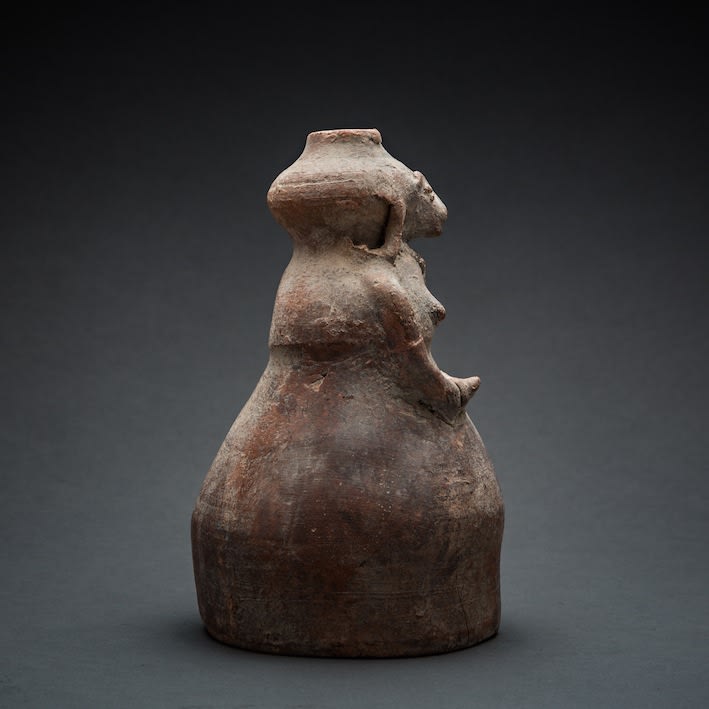Indus Valley Terracotta Figurine of a Fertility Goddess, 2800 BCE - 2700 BCE
Terracotta
height 20.8 cm
height 8 1/8 in
height 8 1/8 in
LO.594
Further images
This terracotta figurine appears almos appears utilitarian. Lacking legs all together, he torso emerges from a wide, cylindrical base that bend at the hips and tappers inwards towards her waist....
This terracotta figurine appears almos appears utilitarian. Lacking legs all together, he torso emerges from a wide, cylindrical base that bend at the hips and tappers inwards towards her waist. She holds her arms down in front of her with her hand held open palm upwards in a gesture of receiving. Her breasts are wel accentuated. Jewelry adorns her body, including necklace with a large circural central pendant and pair of dangling earrings. The bridge of her nose i quite prominent, curving into her brow that frames he coffee bean eyes. Her hair has been styled into thre buns that top her head, or she may wear a headdress o crown.
The Indus Civilization is still enigmatic: an ancient civilization with a yet-to be deciphered writing system, a mysterious monumental architecture, no monumental art, a puzzling decline, and little evidence of the identity of its direct descendants. In a civilization extending over an area so vast, one would expect to find monumental art and/or architectural symbols of power displaying the names of the powerful. Instead, the emphasis is placed on small, elegant art and sophisticated craft technology.
Three-dimensional representations of living beings in the Harappan world are confined to a few stone and bronze statues and some small objects crafted in faience, stone, and other materials - with one important exception. Ranging variously in size, the anthropomorphic and animal terracotta figurines the Indus Civilization sites depict life as seen by the Harappan people in the Bronze Age. Terracotta figurines have long been considered toys, often without question. The earliest anthropomorphic figurines from Harappa date back to the Early Harappan (Ravi Phase, Period 1, and Kot Diji Phase, Period 2) levels. Among these are stylized seated female figurines with exaggerated buttocks and thighs and joined legs extended in front.
However, large terracotta figurines thrown on the wheel such as this one, mostly seem to have come from the valley of Bajaur in Pakistan, where a distinctive style of semi-realistic anthropomorphic figurines was allegedly produced during the early 3rd millennium BCE. Incredibly enough, the extraordinary blend of realism -imbued in the detailed torso and arms of this figurine, and surrealism -of her large almost zoomorphic facial traits- would not feel out of place in a contemporary setting, thus transcending the boundaries of time and space. This figure appears to recall some of th earliest neolithic fertility idols, to whom she i most likely related. Surely, she exudes an energ befitting such an ancient goddess.
The Indus Civilization is still enigmatic: an ancient civilization with a yet-to be deciphered writing system, a mysterious monumental architecture, no monumental art, a puzzling decline, and little evidence of the identity of its direct descendants. In a civilization extending over an area so vast, one would expect to find monumental art and/or architectural symbols of power displaying the names of the powerful. Instead, the emphasis is placed on small, elegant art and sophisticated craft technology.
Three-dimensional representations of living beings in the Harappan world are confined to a few stone and bronze statues and some small objects crafted in faience, stone, and other materials - with one important exception. Ranging variously in size, the anthropomorphic and animal terracotta figurines the Indus Civilization sites depict life as seen by the Harappan people in the Bronze Age. Terracotta figurines have long been considered toys, often without question. The earliest anthropomorphic figurines from Harappa date back to the Early Harappan (Ravi Phase, Period 1, and Kot Diji Phase, Period 2) levels. Among these are stylized seated female figurines with exaggerated buttocks and thighs and joined legs extended in front.
However, large terracotta figurines thrown on the wheel such as this one, mostly seem to have come from the valley of Bajaur in Pakistan, where a distinctive style of semi-realistic anthropomorphic figurines was allegedly produced during the early 3rd millennium BCE. Incredibly enough, the extraordinary blend of realism -imbued in the detailed torso and arms of this figurine, and surrealism -of her large almost zoomorphic facial traits- would not feel out of place in a contemporary setting, thus transcending the boundaries of time and space. This figure appears to recall some of th earliest neolithic fertility idols, to whom she i most likely related. Surely, she exudes an energ befitting such an ancient goddess.





